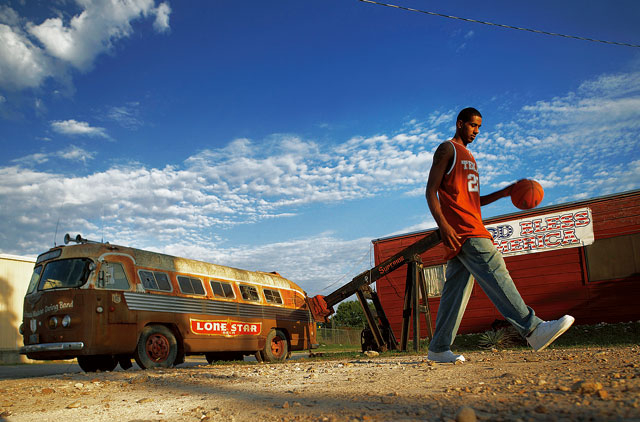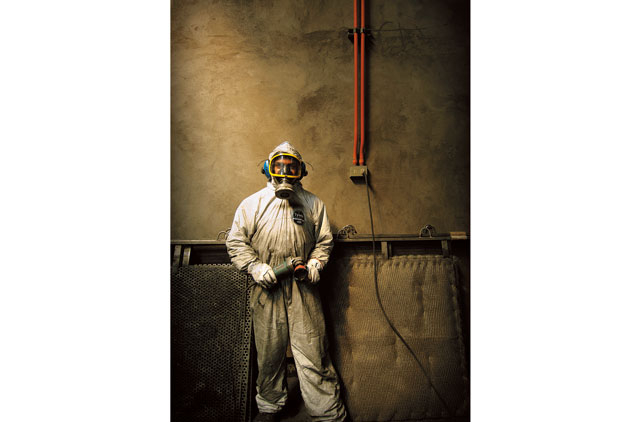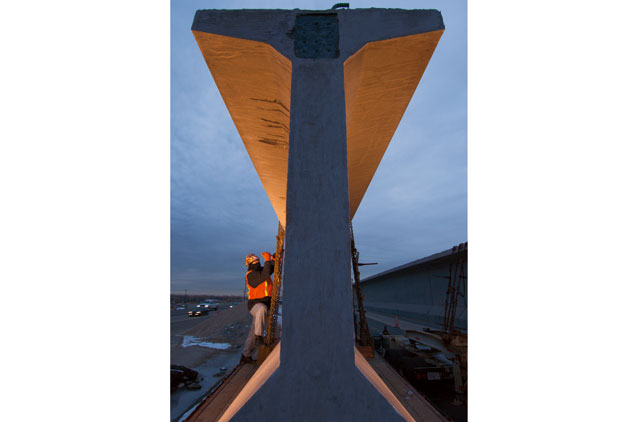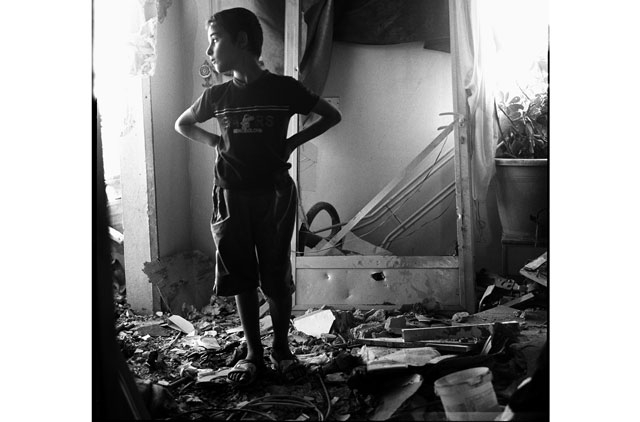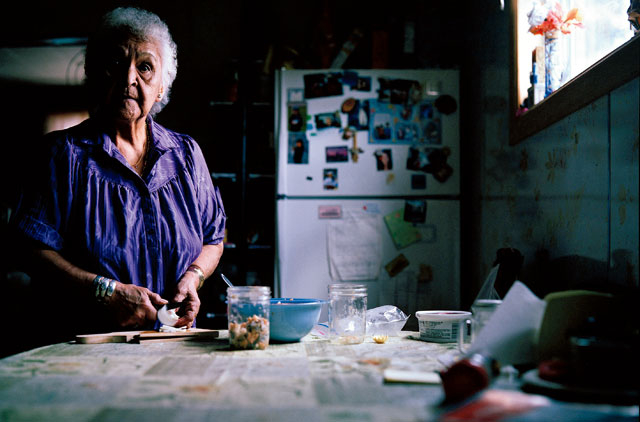
Gulf Photo Plus is back. Dubai's annual tryst with the world of images holds great promise for professional and amateur photographers keen to learn from world-renowned multi-genre artists visiting the show.
A variety of workshops organised for beginners and moderately skilled photographers will help both kinds of photographers learn the ropes. Friday takes a look at the work of three photographers of international repute who specialise in taking portraits but have a dramatically different approach.
Gregory Heisler loves to capture the essence of a person through his cover portraits, while David Tejada specialises in corporate photography with his unique interpretation. Farah Nosh pulls out all the stops when shooting in war zones. Their sensibilities and responses to their subjects and attention to detail make them masters of their work.
Gregory Heisler
Capturing people power
With at least 70 TIME covers to his credit as well as a string of assignments with iconic businesses, award-winning New York photographer Gregory Heisler is known for his evocative portraiture style. "All my experience, expertise, passion and creativity go into the making of these images," says Heisler who has done assignments for Life, National Geographic among others and photographed people like Bill and Melinda Gates, Michael Moore, Rudy Giuliani, Michael Bloomberg, Bono and Bill Clinton to name a few. Heisler will be teaching at GPP workshops.
The world according to Gregory Heisler
I'm only a small photographer. The world's a big place. I have a profound love and respect for people and I try to convey these feelings through my work.
70 covers for TIME magazine! How do you respond to the exclamatory responses from people?
While I'm very flattered, every single one was hard-earned. They were never formulaic each was individually conceived and executed based on the person, story, magazine, and moment.
You have photographed thousands of people. What is the most important endearing feature on the human face?
I love to see the story in every face. The eyes are always the key.
What are the aspects of picture composition that you keep in mind when doing a portrait shot?
I don't think of composition as a set of rules. I think of myself as a tour guide. I use lighting and composition to guide the viewer through my image.
The most important lesson you impart to your students?
Be yourself. It's the one unique things you can bring to your work.
Your biggest picture coup?
There were several. My first LIFE magazine cover. My first TIME magazine cover. .. The black-and-white cover essay on Muhammad Ali and his entourage for Sports Illustrated magazine. It was a real turning point in my career, the first time I used the technical and lighting skills I'd developed to establish and communicate an emotional tone in a visual way.
Your biggest picture upset?
A portrait of the warm and gracious actress Doris Day. I tried to do too much and came away with too little. I learned a great lesson that day.
The picture you have always wanted to shoot?
I'd love, without any agenda, to really photographically explore a person, to not be in a rush, to not have to please anyone, to not have to be entertaining or make conversation; to just look and see and study and appreciate and create; to pay attention to gesture and light and shadow and hue and texture and time. That's all.
David Tejada
Beyond the corporate veneer
Had Picasso been reborn as a photographer, he would have been somewhat like Colorado-based David Tejada who has reinterpreted corporate portraiture imbuing it with the vibrant colours of life. Be it a CEO or depicting the intricate features of a miner at work, Tejada lends his unique perspective to his portraits. Tejada will be holding workshops at GPP.
How do you balance the art of photography with commerce as a corporate photographer? Do you have to compromise as a photographer for the sake of being a good businessman?
That's a wonderful question. When I was new to the business of corporate photography, I was more likely to compromise or felt as though I needed to create safe images that told my clients' story. As I grew more confident, I would search for more creative ways to illustrate my clients' message.
Things you do for aesthetic appeal in an otherwise strait-laced corporate/industrial subject?
The most important issue when shooting corporate and particularly industrial environments, is to make the image look believable, especially with industrial photography. Safety is of the highest priority and that must show in every photo. Once you have those two aspects covered, unique angles, lens selection and framing need to come together to form striking images. One thing pleases me in particular - I know that if I am satisfied, my client will be as well, or at least I hope so.
Your corporate pictures are about people in power. Do you endeavour to highlight this aspect of empowerment?
When photographing the CEO of a corporation, I try to convey a sense of power, confidence, and approachability of that individual using the best environment or setting available as well as body positions and gestures.
What is your favourite subject?
I'm a sucker for heavy industry. Shooting heavy industry is particularly fun for me, because it is often thought of as being dirty and unglamorous. I like the challenge of creating unique images that are interesting to look at as well as inform. Shooting 300 metres underground in a salt mine, from helicopters in the Andes, photographing open-heart surgery ... I have got to be the luckiest guy in the world.
When doing still life, what are the things you keep in mind for the best results?
The most important thing for me is directing the viewer's eye to the product or elements of most importance in the photo. I do this by leading lines and lighting. I try not to make it busy, simple is better.
Tips for aspiring corporate photographers
Have an interest in business and people; a very diverse portfolio; be professional at all times; live below your means; be a good business person. There are more people with moderate talent and great business skills working than there are people with moderate business skills and great talent".
Farah Nosh
Documenting life
Canadian-born Farah Nosh of Iraqi origin, is one of those rare fresh breeds of documentary photographers who like to feel and live every situation they photograph and get under the skin of their subject to relive the pain and agony of a war. She has lived in many war zones around the world to be able to do that. A photographer who wants to capture the resilience and triumph of human spirit in the face of the worst crisis. Nosh is also passionate about capturing the last speakers of a language becoming extinct which she did with great success with the speakers of an almost extinct Alaskan language called Haida.
You have documented human pain and suffering from Iraq, to Afghanistan to Palestine, to Lebanon. How different or similar was your experience?
What is similar is the capacity to which people can endure. I'm incredibly moved when I see a family cooking dinner amidst the rubble of their home or kids playing with the sounds of drones overhead. What is different is the combination of politics and security. Iraq's streets were incredibly dangerous for a long time, it was hard to move around and work. Lebanon was dangerous aerially, Palestine can be hard just to get in and Afghanistan was challenging because I needed a translator there. I much prefer working alone, it's easier to connect with people talking to them directly.
Would you say your depiction of people under siege and victims of violence, captures the silent power of resilience or does it show powerlessness against might?
I think it's both. I see resilience as empowering. Resilience is like saying, ‘We will not be defeated.' Victims of war don't have a choice. They don't sign up for war. So yes, there is powerlessness too. Does that make sense that I see the powerlessness in the lack of choice, and yet I see their empowerment through their resilience?
If pictures speak a thousand words what do your pictures say about the world as we see it today?
I always find it hard to describe what my pictures say. The fire is about humanising. Humanising what is often dehumanised.
How difficult or easy it is to be impervious to human suffering for the sake of documenting it? Is it possible to actually not get involved or affected by the subject of your photographs?
A deep sense of compassion is what leads photographers to do this kind of work. It's hard to imagine that we could possibly be impervious to the suffering...but we all deal with it in different ways. Sometimes the camera works as a filter in a situation. If I put my camera down and really allow myself to be present and feel the situation, I'll break down. How could somebody photograph a pile of dead children and stay removed?
What do you think is the real strength of a picture - the subject or the technique
Subject and light. Nice light always makes a difference. Technique? I never feel like I really know what I'm doing. I just chase after great stories and great light.
What is large format photography and how did it help you document the life of the last known inhabitants of Alaska speaking the fast-disappearing Haida language?
Large format photography uses a single sheet (4x5 inch) negative. You get one shot per sheet. It really slows the shooting process down. Every frame is very intentional. I felt this was an honourable way to photograph the elders who are the last to carry their Haida language in the Pacific Northwest coast of Canada, and Alaska.
Your best/most memorable picture so far?
So hard to say. A photo of two young brothers in a van in Aitaroun, southern Lebanon, during the war of 2006. Their fear is something I always remember.
The most poignant moment of your career.
Having my work from Iraq in 2006 published and winning an award. It was a huge challenge in terms of security to do the work, and support. I pitched the stories before I left but couldn't get a commitment or a dime. I was told, ‘we can't see how you'll get the access to do the story.' It pushed me even harder to get access and to come home with the stories.
The lessons you have learnt from your career in documentary photography.
That I'm not going to change the world.
The people in the world you want to photograph.
I want to continue photographing the last speakers of dying languages.
Event info
What: The Gulf Photo Plus 2011
Website: For more details about workshops and reservations log onto: www.kv.ae/page/location-map
When: March 7-11
Where: Dubai Knowledge Village, Block I, Conference Centre


